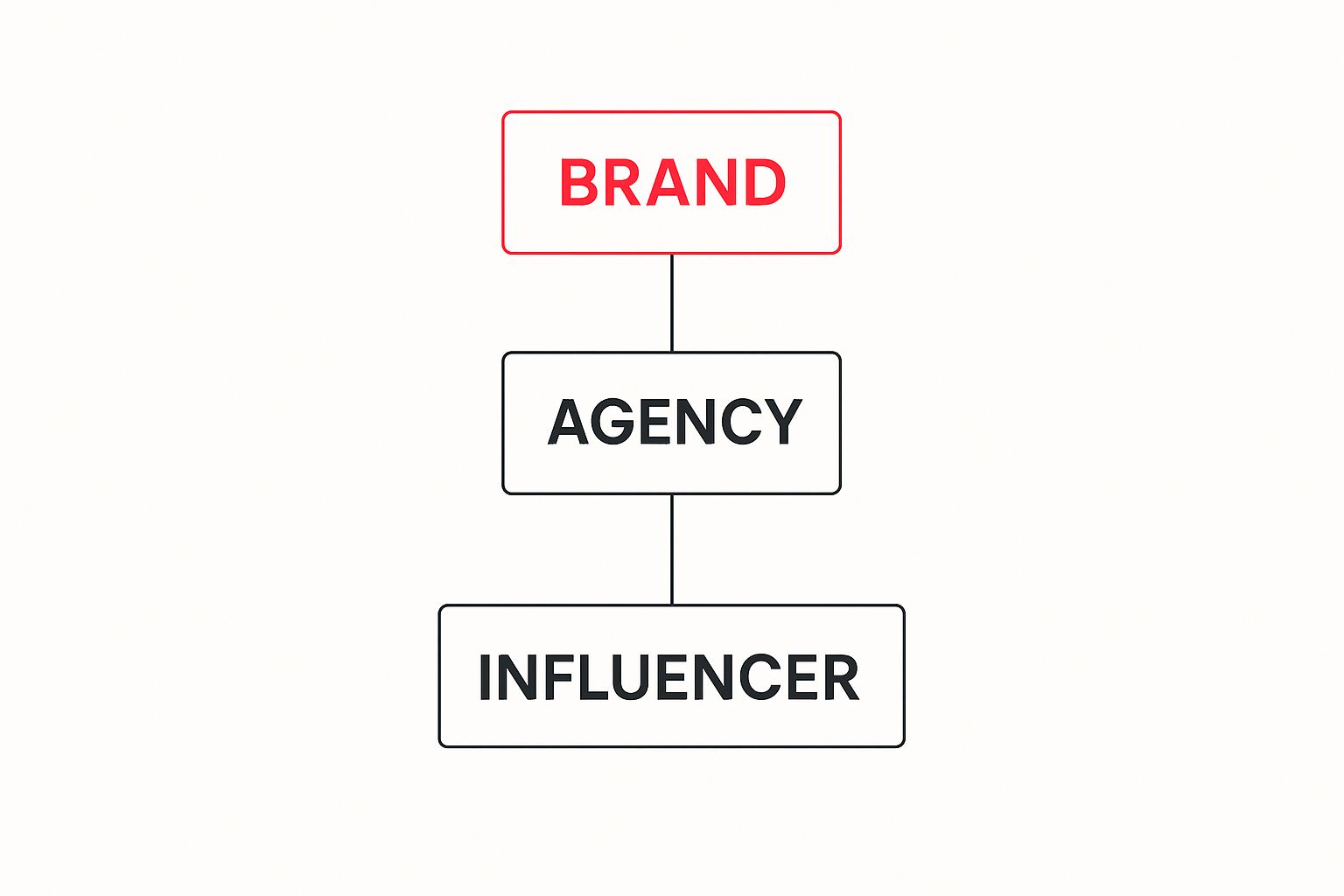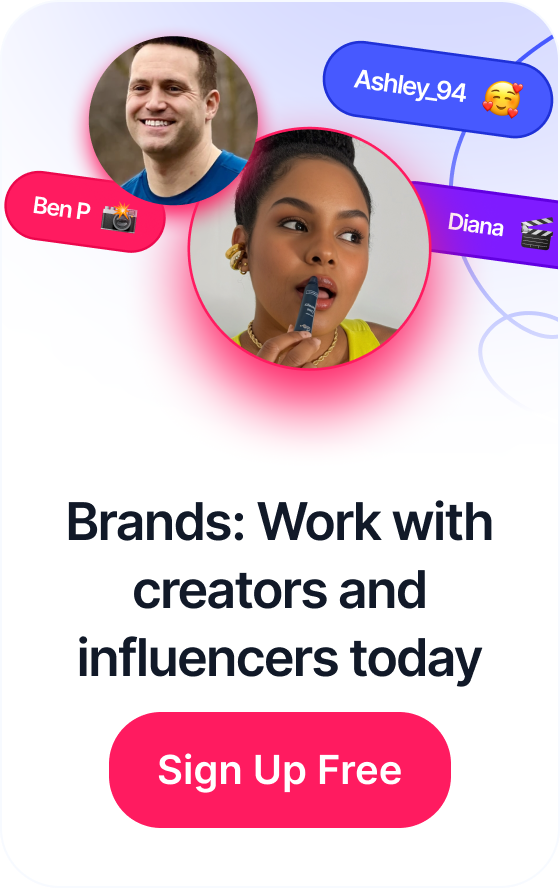 How to Monetize Mobile Apps for Maximum Revenue
How to Monetize Mobile Apps for Maximum Revenue
Think of an influencer agreement contract as the official rulebook for your collaboration. It’s a legally binding document that lays out the entire partnership between a brand and a creator, making sure everyone is on the same page before the campaign kicks off. It's the blueprint that ensures both sides are protected and totally aligned on goals, deliverables, and expectations.
Table of Contents
Why An Influencer Agreement Contract Is Non-Negotiable

Starting a creator collaboration without a contract is like trying to build a house without a blueprint. Sure, the initial chats might feel great and full of promise, but handshake deals and verbal agreements are notorious for leading to mismatched expectations, content disputes, and even ruined relationships.
An influencer contract turns all that ambiguity into crystal-clear clarity. It serves as a shared roadmap that guides both parties toward a successful, professional partnership. This document is far more than just a formality; it’s a strategic tool. It forces you and the influencer to hash out every critical detail upfront, creating a solid foundation built on mutual respect and accountability.
Defining The Partnership Framework
A well-drafted agreement provides a clear framework for the whole project. It establishes the ground rules from day one. If questions or disagreements pop up later—and they sometimes do—you have a written source of truth to fall back on. This simple step is often what separates a smooth, effective campaign from a chaotic, disappointing one.
Modern influencer marketing is a professional business, not an informal hobby. Just look at the structured approach highlighted in Wikipedia's entry on influencer marketing, where formal agreements are fundamental.

This structure reinforces why contracts are absolutely essential for anyone serious about getting results.
An influencer contract isn’t about restricting creativity; it’s about providing the freedom to create within a clear, mutually agreed-upon structure. It protects both parties by ensuring there are no surprises down the line.
To show you exactly why this is so important, let's break down the core components that every solid agreement should include. These elements are what turn a simple document into a powerful tool for campaign success.
Core Components of an Influencer Agreement Contract
A strong contract doesn't need to be overly complex, but it must cover the essentials. Here’s a quick summary of the must-have clauses that ensure clarity and protection for both brands and creators.
| Component | Purpose and Importance |
|---|---|
| Scope of Work | Clearly defines all deliverables, such as the number of posts, stories, or videos required. This eliminates any confusion about what the influencer needs to produce. |
| Compensation & Payment | Details the payment amount, method, and schedule. This ensures the creator is paid fairly and on time, preventing financial disputes. |
| Content Usage Rights | Specifies how and where the brand can use the influencer's content. This protects the creator's work and gives the brand clear permissions for repurposing assets. |
| Exclusivity Clause | Outlines whether the influencer can work with competing brands during the campaign period. This safeguards the brand’s investment and message. |
| FTC Disclosure Rules | Ensures the influencer agrees to comply with legal advertising guidelines, like using #ad, protecting the brand from legal and reputational risk. |
Getting these five elements right from the start will save you countless headaches and set your partnership up for a win.
Decoding the Key Clauses in Your Contract
At first glance, an influencer agreement can feel like a wall of dense legal text. It’s intimidating. But if you think of it as a set of building blocks, where each piece has a specific job, it suddenly becomes much more manageable. Each clause is just another instruction in the blueprint for your collaboration.
Let’s cut through the jargon and really look at the anatomy of a solid agreement. Getting these core parts right is your best bet for protecting your brand, setting clear expectations, and laying the groundwork for a partnership that actually works.
The Scope of Work Is Your Campaign Blueprint
This is it. If you only pay close attention to one section, make it this one. The Scope of Work (SOW) is where you spell out exactly what the influencer needs to create and deliver. Any fuzziness here is the #1 reason campaigns go off the rails.
Instead of saying something vague like, "promote our new skincare line," a great SOW gets granular. Think in terms of specifics:
- One (1) Instagram Reel, 60-90 seconds long, showing the product in a morning routine.
- Three (3) Instagram Stories, each with a direct link to the product page, posted over three straight days.
- One (1) static image post on their main feed, making sure to tag the brand in both the photo and the caption.
This level of detail leaves zero room for guessing games. It locks in the exact deliverables, formats, and platforms, ensuring both you and the creator are on the same page from day one.
Defining Content Usage Rights
So, the content is created. Now what? Who actually owns it, and what are you allowed to do with it? This is where the Content Usage Rights or licensing clause comes into play. A common mistake brands make is assuming that because they paid for the content, they own it forever and can use it anywhere they want. That's rarely the case unless you explicitly state it in the contract.
Think of it like licensing music. You can pay to play a song on the radio for a set time (a specific use), but that doesn’t give you the right to drop it into a movie soundtrack or a national TV commercial without a totally different—and more expensive—license. Influencer content works the same way.
A well-drafted clause will clearly define:
- Usage Duration: How long do you have permission to use the content? Is it for 6 months, or maybe a full year from the day it's posted?
- Usage Channels: Where can you use it? Is it just for your organic social media accounts, or can you also put it on your brand website and in email newsletters?
- Paid Advertising Rights: Can you boost the content as a paid ad, like a Meta Ad or a TikTok Spark Ad? This almost always requires extra compensation for the creator.
You can certainly negotiate for broader or even perpetual rights, but expect the price to go up accordingly. Getting this clear from the start avoids messy disputes down the road about who owns what.
Navigating Exclusivity and Disclosure
An Exclusivity Clause is your campaign's insurance policy. It stops an influencer from working with your direct competitors for a set amount of time. This is crucial for protecting your brand's message. Imagine the influencer you just hired promotes your new energy drink on Monday, only to post about a competitor’s drink on Friday. It would completely water down your campaign's impact and confuse their followers.
This infographic shows the typical flow of agreements, which often involves multiple parties.

This structure is exactly why having clear, contractual clauses is so important. It keeps everyone aligned and compliant, no matter how many people are involved.
Finally, the contract absolutely must require the influencer to follow advertising laws, like the FTC’s disclosure guidelines. This means adding clear tags like #ad or #sponsored to all paid posts. It not only protects the creator from legal trouble but, more importantly, it protects your brand’s reputation by being transparent with consumers.
The influencer marketing world is getting more professional, and with that comes the need for more buttoned-up contracts. It’s no surprise that 54% of multinational brands are planning to spend more on influencer marketing, and 61% see it as increasingly vital to their strategy. This growth is exactly what’s pushing the need for airtight agreements that cover content rights, exclusivity, and disclosure. If you're looking to dive deeper into these trends, you can review some of the latest influencer marketing resources.
When you take the time to define each of these clauses, your influencer contract stops being a scary legal document and becomes a powerful tool for getting everyone on the same page and ensuring your campaign is a success.
Structuring Fair Compensation and Payment Terms

Let’s talk about the engine of any successful influencer partnership: compensation. Get this part right, and you’ll have a motivated partner who’s genuinely excited to knock it out of the park. Get it wrong, and you risk a campaign that sputters out before it even has a chance to get going.
Thinking about compensation isn't just about throwing a number out there. It's about figuring out all the different ways you can provide real value to a creator. The payment clause in your influencer agreement contract needs to be a direct reflection of the value you expect to get back.
Choosing the Right Payment Model
No two campaigns are identical, so why should your payment structure be? The most common models each have their own pros and cons, and the best fit really boils down to your specific goals and the creator you're working with.
- Flat Fee: This is as straightforward as it gets. You agree on a fixed price for a specific set of deliverables—say, one Instagram Reel and three Stories. It’s a dream for budgeting and perfect for campaigns where brand awareness is the main goal.
- Performance-Based (Commission/Affiliate): With this model, you tie payment directly to results. Think clicks, conversions, or sales tracked through a unique link or discount code. It’s an excellent way to measure ROI directly and is a go-to for sales-focused campaigns.
- Product Gifting (In-Kind): Sometimes, especially when you're working with micro-influencers, the product itself is the payment. This works best when your product has a high perceived value and is something the creator would genuinely use and love.
- Hybrid Model: This is the best of both worlds. You might offer a smaller flat fee combined with a commission on sales. This gives the influencer some guaranteed income for their effort while also giving them a reason to push for tangible results.
Here’s a telling statistic: while 57% of creators are increasing their rates, a surprising 83% are still open to collaborations where the only compensation is free product, as long as the brand is a perfect match. This just goes to show how important it is to be flexible. You can dig into more data on the latest influencer marketing compensation trends.
Setting a Fair Rate
Figuring out a fair rate is so much more than just glancing at a follower count. An influencer's true value is a mix of different factors that all point to their actual impact and the amount of work a campaign requires.
A fair rate isn't just about what you pay; it's about what you get in return. An influencer with 10,000 highly engaged followers in a niche market can be far more valuable than one with 100,000 passive followers.
When you sit down to negotiate, keep these key things in mind to land on a price that respects the creator’s work without blowing your budget:
- Engagement Rate: High engagement—likes, comments, shares—is proof of a dedicated and active audience.
- Content Complexity: A high-production-value video is a world away from a simple static photo post in terms of effort.
- Industry Authority: A respected expert in a niche can command a higher rate because you're also paying for their credibility.
- Usage Rights: If you want to use their content in your paid ads, you can expect to pay a premium for those extensive rights.
Structuring Payment Schedules and Terms
Once you've agreed on a number, the next crucial step is to spell out the payment schedule in the contract. This is all about managing your financial risk while keeping the creator happy and motivated. A common and highly effective structure is paying 50% upfront and 50% upon completion.
This two-part schedule is great for building trust. The upfront payment shows you’re a serious partner and helps the creator cover any production costs. The final payment ensures you get all the content you agreed on before the full amount is released.
Your influencer agreement contract should also spell out these details in black and white:
- Payment Method: How will you pay? Bank transfer, PayPal, or another service?
- Invoice Process: What specific information does the influencer need to include on their invoice?
- Payment Deadline: Specify the payment terms (like Net 15 or Net 30) to set clear expectations for when they'll get paid after invoicing.
Finally, don't forget to talk about expenses. If your campaign needs the influencer to travel or buy props, the contract must be crystal clear about whether you'll reimburse those costs. Nailing down these financial details from the start prevents misunderstandings and helps build a professional, respectful partnership that lasts.
Understanding Legal Guardrails and Compliance

Let's talk about the legal stuff. It’s not the most glamorous part of influencer marketing, but ignoring it is like building a house on a shaky foundation. Sooner or later, things will get messy. An influencer agreement contract is your best tool for keeping everyone protected and on the same page.
Think of your contract as the official rulebook for your collaboration. It lays out all the expectations, protects your brand, and keeps your campaign out of hot water. Without it, you're just hoping for the best, and hope is not a strategy. We'll break down the essentials—from FTC rules to content ownership—into simple, practical terms.
FTC Disclosures: The Art of Being Upfront
The biggest legal tripwire in influencer marketing is disclosure. The Federal Trade Commission (FTC) has a simple but non-negotiable rule: the relationship between a brand and an influencer must be "clear and conspicuous." This isn't a friendly suggestion; it's a mandate to ensure consumers know when they're looking at an ad.
Failing to follow this rule can lead to hefty fines and, just as bad, a loss of trust with your audience. Your contract has to spell this out clearly. The influencer must use obvious disclosures.
- Good to go: #ad, #sponsored, #brandpartner
- Big no-no: #collab, #sp, #thanks[BrandName], or burying #ad at the end of a 30-hashtag pile-up.
The disclosure needs to be immediately visible, not hidden behind a "see more" click. For videos, this means mentioning it in the caption and saying it out loud in the content itself.
To help clear up any confusion, here’s a quick-reference table for making sure your disclosures are on point across the most popular platforms.
Disclosure Do's and Don'ts (FTC Guidelines)
| Platform | Do (Best Practice) | Don't (Common Mistake) |
|---|---|---|
| Instagram/Threads | Use #ad or #sponsored at the very beginning of the caption. Use the platform's built-in "Paid Partnership" tool. | Hiding #ad in a long list of hashtags or only using the partnership tool without a text disclosure. |
| TikTok | Place #ad or #sponsored clearly in the first line of the video description. Toggle on the "Branded content" setting. | Relying only on the platform's content toggle. The hashtag is still essential for clarity. |
| YouTube | Verbally disclose the partnership within the first minute of the video. Check the "includes paid promotion" box in settings. Include #ad in the video description. | A verbal disclosure buried at the end of a long video. Not including a text disclosure in the description box. |
| Use the Branded Content tool to tag the brand partner. Also include a clear text disclosure like #ad or #sponsored. | Assuming the tag alone is enough. Some users may not recognize what the tag means. |
This table isn't exhaustive, but it covers the common pitfalls. The goal is always transparency—if a consumer has to guess if it's an ad, you're doing it wrong.
Clarifying Intellectual Property and Ownership
One of the most frequent arguments I see is over who owns the content. When an influencer creates photos or videos for your campaign, who gets the rights to use them? Your agreement has to settle this question from the start.
By default, the creator owns the copyright to their work. This means without a specific agreement, you can't just take their content and splash it across your website, email newsletters, or run it as a paid ad. Your contract must define the intellectual property (IP) rights you're getting.
A strong contract acts as a deed for digital property. It clearly outlines who owns the content, for how long, and where it can be displayed, preventing any future claims or misunderstandings about usage rights.
Get specific on these points:
- Usage Term: Do you have the rights for six months, a year, or forever (in perpetuity)?
- Channels: Can you only use it on Instagram, or does the license cover your website, print materials, and digital ads too?
- Modification Rights: Are you allowed to crop the photo, add a text overlay, or chop up a video for a highlight reel?
Broader rights, especially for paid advertising, will cost more. But it's far cheaper to negotiate this upfront than to try and get the rights after the fact when the content is already performing well.
The Importance of Confidentiality and Termination Clauses
Sometimes, you'll need to share sensitive information with an influencer—maybe details about a secret product launch or your internal marketing plans. A confidentiality clause, often called an NDA, is crucial. It creates a legal obligation for the influencer to keep your private business information under wraps.
But what if the partnership just isn't working out? A termination clause is your escape hatch. It's a pre-agreed plan for how either party can walk away. This clause should outline the specific reasons the contract can be ended, such as:
- Missing deadlines or delivering poor-quality content.
- The influencer working with a direct competitor (if you have an exclusivity clause).
- The influencer getting involved in a scandal that could damage your brand's reputation (this is often called a morality clause).
This section should also state what happens after termination. Does the influencer have to return a portion of their fee? Do they need to take the content down? Defining the exit strategy upfront keeps a potential breakup professional and out of the courtroom.
Building Long-Term Partnerships with Stronger Contracts
The world of influencer marketing is growing up. Gone are the days of just chasing quick, one-off campaign hits. Smart brands are now playing the long game, focusing on building deeper relationships that turn creators from temporary megaphones into true brand ambassadors. This shift demands a whole new way of thinking about your influencer contracts.
An agreement built for a single campaign is worlds apart from one designed to last a year or more. Think of it like a rental agreement versus a marriage certificate—one is purely transactional, while the other signals a much deeper, ongoing commitment. A long-term contract has to be built from the ground up to support and nurture that extended relationship.
This means you can't just recycle your old templates. You have to rethink the core clauses to reflect a more integrated partnership, moving from a simple list of "you will post this" to a flexible framework for mutual growth.
Crafting Contracts for Lasting Ambassadorships
When you're building a sustained partnership, your contract needs to be far more robust. It has to anticipate the twists and turns of a longer relationship, providing a clear roadmap for how you and the creator will work together over months, not just a few weeks. This all comes down to building in flexibility and focusing on performance.
The real goal here is to draft an agreement that feels less like a rigid set of rules and more like a shared business plan. When you get this right, you give the creator a sense of ownership, which encourages them to pour their authentic voice and energy into your brand's long-term success.
For these kinds of partnerships, your influencer agreement needs to adapt in a few key areas:
- Ongoing Deliverables: Instead of a fixed list of posts, think in terms of a consistent content cadence. For example, you might agree on two videos and four stories per month. This gives your brand a steady stream of content while giving the creator the flexibility they need to stay creative.
- Extended Exclusivity: A true long-term partnership often requires broader exclusivity. This clause would prevent the creator from working with any direct competitors in your category for the entire length of the contract, protecting your investment and keeping your brand's message consistent.
- Performance Incentives: Don't just stick to a flat fee. The best long-term contracts align everyone's goals by incorporating bonuses tied to real-world performance metrics (KPIs) like lead generation, conversion rates, or even audience growth.
Tying Contracts to Real Business Outcomes
The biggest change in modern influencer agreements is the pivot away from vanity metrics. Follower counts and likes are taking a backseat to measurable ROI. Today’s contracts are all about tangible business results, and this data-driven mindset is completely reshaping how brands invest in creators.
This evolution shows a clear trend: brands want to see a real return on their investment. It's why 80% of brands either kept or grew their influencer marketing budgets recently, with 47% of them boosting their spend by at least 11%. This isn't happening in a vacuum; it’s fueled by a major shift away from surface-level metrics toward performance indicators that actually mean something for the business.
A modern influencer agreement contract should track metrics that directly impact your bottom line, such as sales generated through affiliate links, unique discount code usage, or click-through rates on campaigns.
Ultimately, the contract is just the starting point. The real magic happens when you foster these relationships so well that you're strategically turning influencers into brand advocates who champion your products because they genuinely believe in them.
When you build contracts that reflect this deeper, more strategic approach, you’re not just hiring a creator—you’re laying the foundation for a partnership that delivers authentic advocacy and measurable growth for years to come.
Actionable Tips for Negotiation and Contract Management
Getting a fantastic influencer agreement signed is a huge milestone, but the real work starts now. That document isn't just a file to be stored away; it’s a living, breathing guide for making the partnership a massive success. This final step is all about transforming a piece of paper into a strong, professional relationship.
The goal here isn't to "win" the negotiation. It's to build a fair agreement that both you and the creator are genuinely excited about. Think of it like you're co-creating the rules of the game so everyone can play their best and come out on top. When you approach it this way, you're building a foundation of mutual respect right from the very first conversation.
Advice for Brands During Negotiation
As a brand, your job is to protect your investment while building a great relationship that could last for years. How you handle the negotiation sets the tone for everything that follows. You need to be firm on your non-negotiables but ready to be flexible where it counts.
Here are a few strategies that have worked for countless brands:
- Stand Firm on Compliance: Your legal guardrails are non-negotiable. This means things like FTC disclosure requirements and confidentiality clauses. These aren't just suggestions; they protect your brand from some serious legal and PR headaches down the road.
- Be Flexible on Creative and Compensation: This is where you need to listen. The creator is the expert on their audience. A small concession on their rate or giving them a bit more creative freedom can lead to content that’s far more authentic and blows your KPIs out of the water.
- Explain the "Why": If a creator pushes back on something, like an exclusivity clause, don't just shut them down. Explain the strategic thinking behind it. Let them know it's to protect the campaign's integrity and ensure the partnership is as successful as possible. It shows you see them as a partner, not just a vendor.
Advice for Creators Reviewing Contracts
For creators, that contract is your best friend. It’s the single most important tool you have to protect your business, your brand, and your creative energy. It is absolutely critical to read through every single line before you even think about signing. Don’t ever be afraid to speak up and fight for what you're worth.
A contract is a two-way street. As a creator, you have the right and the responsibility to review, question, and request revisions to ensure the terms are fair, clear, and reflective of the value you provide.
When a brand sends over a contract, here's your game plan:
- Read Every Single Word: Seriously. Pay super close attention to the scope of work, content usage rights, and payment terms. These are the areas that will have the biggest impact on your workload and your bank account.
- Recognize Your Full Value: Your value isn't just your follower count. It's your engagement rate, the jaw-dropping quality of your content, and the deep trust you've built with your community. Bring these points to the table to justify your rates.
- Confidently Request Revisions: See a clause that feels a bit off or just plain unfair? Propose an alternative. Use clear, professional language to explain why you're asking for the change. For example, if the usage rights feel way too broad, you can suggest something like, "Could we limit the usage rights to 6 months on Instagram and Facebook only?"
Managing the Partnership Post-Signature
Signing the contract isn't the finish line—it's the starting gun. From this point on, the agreement is your shared playbook for navigating the collaboration. If questions or issues pop up, you both have a guide to refer back to.
Keep the lines of communication wide open. If someone seems to be forgetting a commitment, a gentle reminder referencing the contract is all it takes. When you manage it right, your influencer agreement contract becomes the blueprint for a strong, respectful, and incredibly successful professional relationship.
Frequently Asked Questions
When you start digging into influencer agreement contracts, a lot of questions can pop up, especially if you're new to the world of creator collaborations. Let's tackle some of the most common uncertainties we see from both brands and creators.
Do I Need a Contract for Unpaid Collaborations?
Yes, you absolutely do. Even if it's just a product-for-post exchange with no money changing hands, a contract is your best friend. It protects everyone by clearly spelling out the important stuff like deliverables (e.g., one Instagram post and three stories), content usage rights (can you use their photo in your ads?), and the timeline for everything.
Flying without a signed agreement is just asking for misunderstandings. It's a fast track to damaging a good relationship and can even lead to messy disputes over who actually owns the content. A simple contract makes the partnership official and gets everyone on the same page right from the get-go.
What Is the Most Common Contract Mistake?
The biggest and most costly mistake we see is vague language, especially when it comes to content usage rights. A lot of brands fall into the trap of thinking that once they've paid for a piece of content, it's theirs to use forever, wherever they want.
Unless it's spelled out in black and white, the rights you have to a creator's content are probably very limited. Ambiguity here is one of the top reasons for legal headaches, making precise language non-negotiable in any influencer agreement.
A solid agreement will get super specific, defining:
- Where the content can be used (e.g., "brand's organic social media channels only").
- How long it can be used (e.g., "one year from the initial post date").
- If it can be repurposed for paid advertising campaigns.
Who Typically Drafts the Agreement?
Nine times out of ten, the brand or its agency will send over the first draft. This makes sense, as they usually have standard legal templates ready to go that protect their interests and match their campaign goals.
But that doesn't mean a creator should just sign it without a second thought. It's crucial for creators (or their managers) to read every line carefully and get a lawyer to look it over if anything feels off. Creators should feel totally comfortable pushing back and negotiating clauses on payment, usage rights, and exclusivity to make sure the deal is fair for everyone involved.
Ready to connect with a network of over 250,000 creators and streamline your next campaign? With JoinBrands, you can create detailed campaign briefs, match with the perfect influencers, and manage your entire workflow in one place.
Launch your next successful influencer campaign today.








